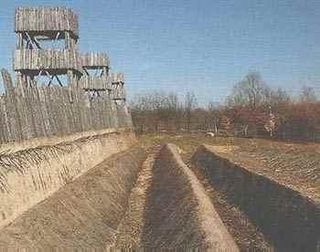 W
WThe Battle of Alesia or Siege of Alesia was a military engagement in the Gallic Wars around the Gallic oppidum of Alesia in modern France, a major centre of the Mandubii tribe. It was fought by the Roman army of Julius Caesar against a confederation of Gallic tribes united under the leadership of Vercingetorix of the Arverni. It was the last major engagement between Gauls and Romans, and is considered one of Caesar's greatest military achievements and a classic example of siege warfare and investment; the Roman army built dual lines of fortifications—an inner wall to keep the besieged Gauls in, and an outer wall to keep the Gallic relief force out. The Battle of Alesia marked the end of Gallic independence in modern day territory of France and Belgium.
 W
WThe Battle of the Arar was fought between the migrating tribes of the Helvetii and six Roman legions under the command of Gaius Julius Caesar in 58 BC. It was the first major battle of the Gallic Wars and ended in a tactical victory for the outnumbered Roman army.
 W
WThe Battle of Bibracte was fought between the Helvetii and six Roman legions, under the command of Gaius Julius Caesar. It was the second major battle of the Gallic Wars.
 W
WThe Battle of Ilerda took place in June 49 BC between the forces of Julius Caesar and the Spanish army of Pompey Magnus, led by his legates Lucius Afranius and Marcus Petreius. Unlike many of the other battles of the civil war, this was more a campaign of manoeuvre than actual fighting. It allowed Caesar to eliminate the threat of Pompey’s forces in Spain and face Pompey himself in Greece at the Battle of Pharsalus.
 W
WThe Battle of the Axona was fought in 57 BC, between the Roman army of Gaius Julius Caesar and the Belgae. The Belgae, led by King Galba of the Suessiones, attacked, only to be repelled by Caesar. Fearing an ambush, the Romans delayed their pursuit. Caesar's Commentarii de Bello Gallico describes this battle at 2.7 - 2.11.
 W
WThe Battle of the Nile in 47 BC saw the combined Roman–Egyptian armies of Julius Caesar and Cleopatra VII defeat those of the rival Queen Arsinoe IV and King Ptolemy XIII and secure the throne of Egypt.
 W
WThe Battle of the Sabis, also known as the Battle of the Sambre or the Battle against the Nervians, was fought in 57 BC near modern Saulzoir in Northern France, between Caesar's legions and an association of Belgae tribes, principally the Nervii. Julius Caesar, commanding the Roman forces, was surprised and nearly defeated. According to Caesar's report, a combination of determined defence, skilled generalship, and the timely arrival of reinforcements allowed the Romans to turn a strategic defeat into a tactical victory. Few primary sources describe the battle in detail, with most information coming from Caesar's own report on the battle from his book, Commentarii de Bello Gallico. Little is therefore known about the Nervii perspective on the battle.
 W
WThe Battle of Vosges, also referred to as the Battle of Vesontio, was fought on September 14, 58 BC between the Germanic tribe of the Suebi, under the leadership of Ariovistus, and six Roman legions under the command of Gaius Julius Caesar. This encounter is the third major battle of the Gallic Wars. Germanic tribes crossed the Rhine, seeking a home in Gaul.